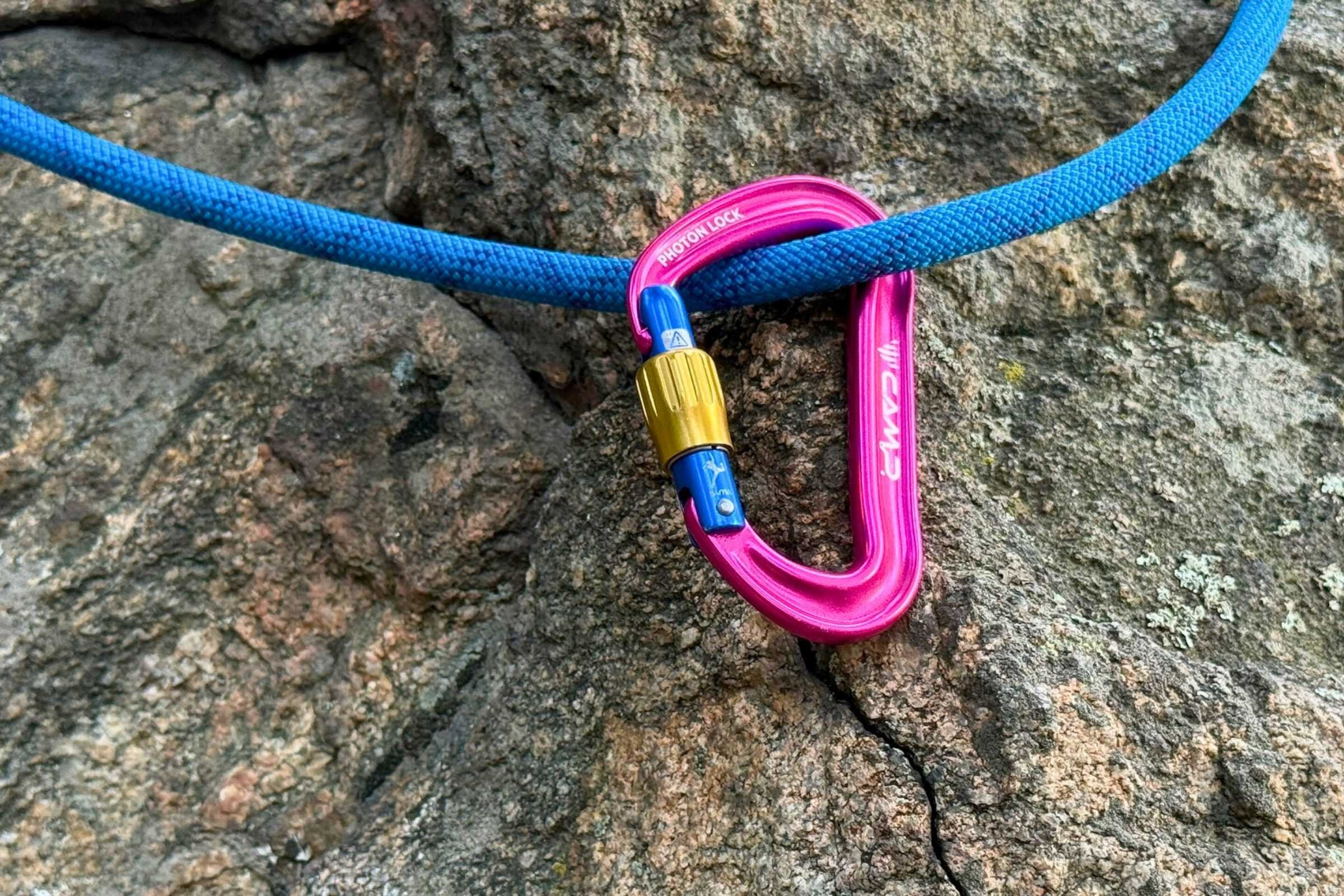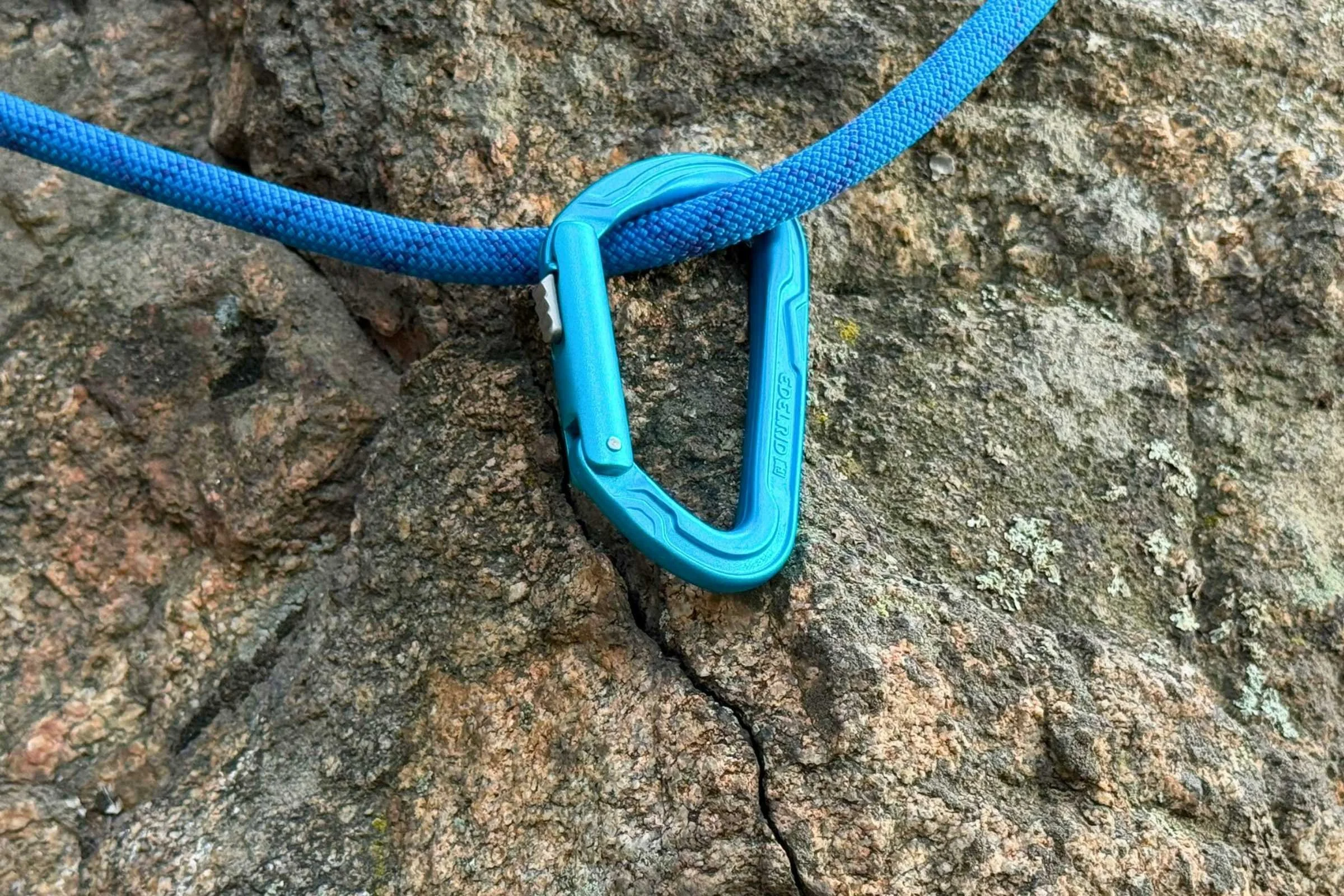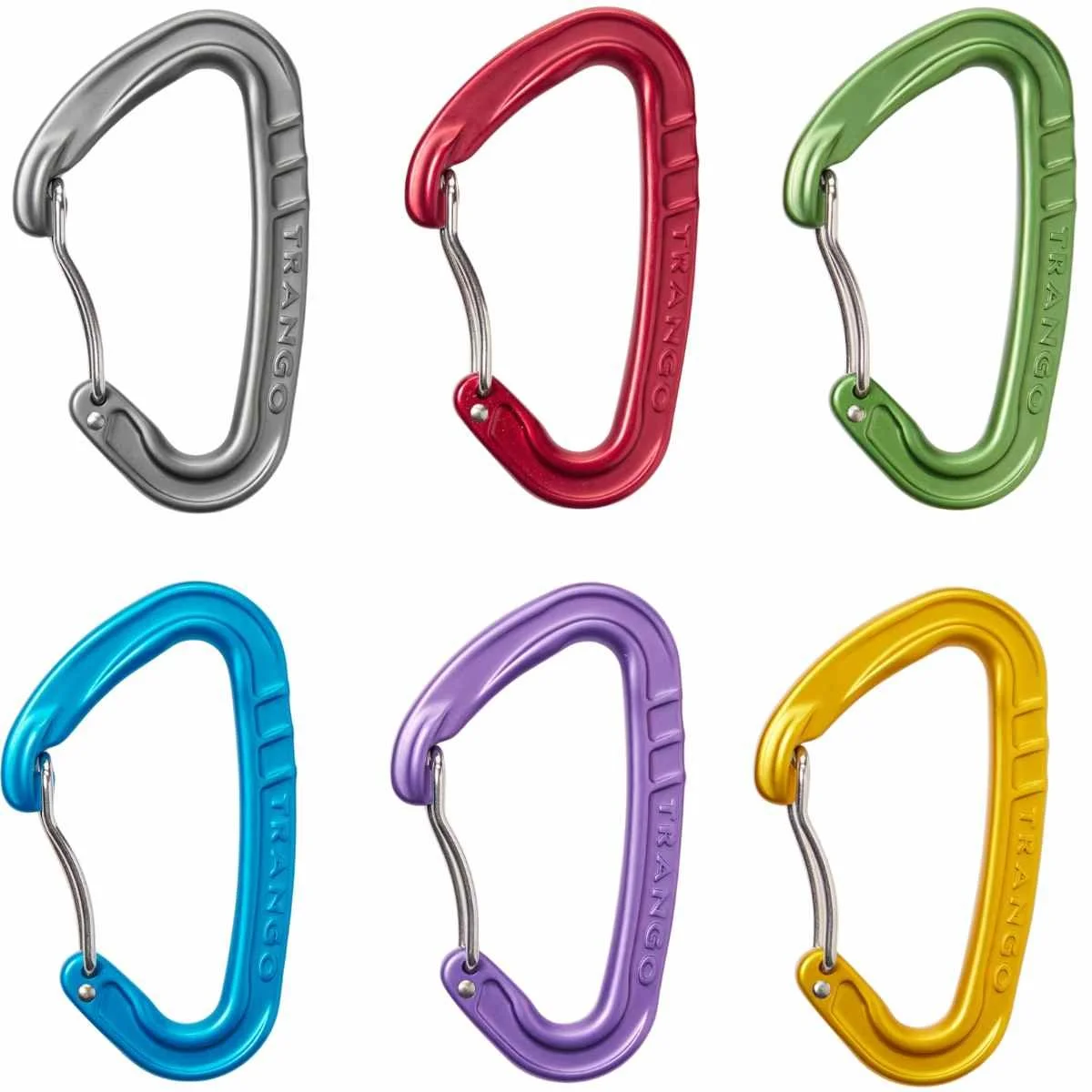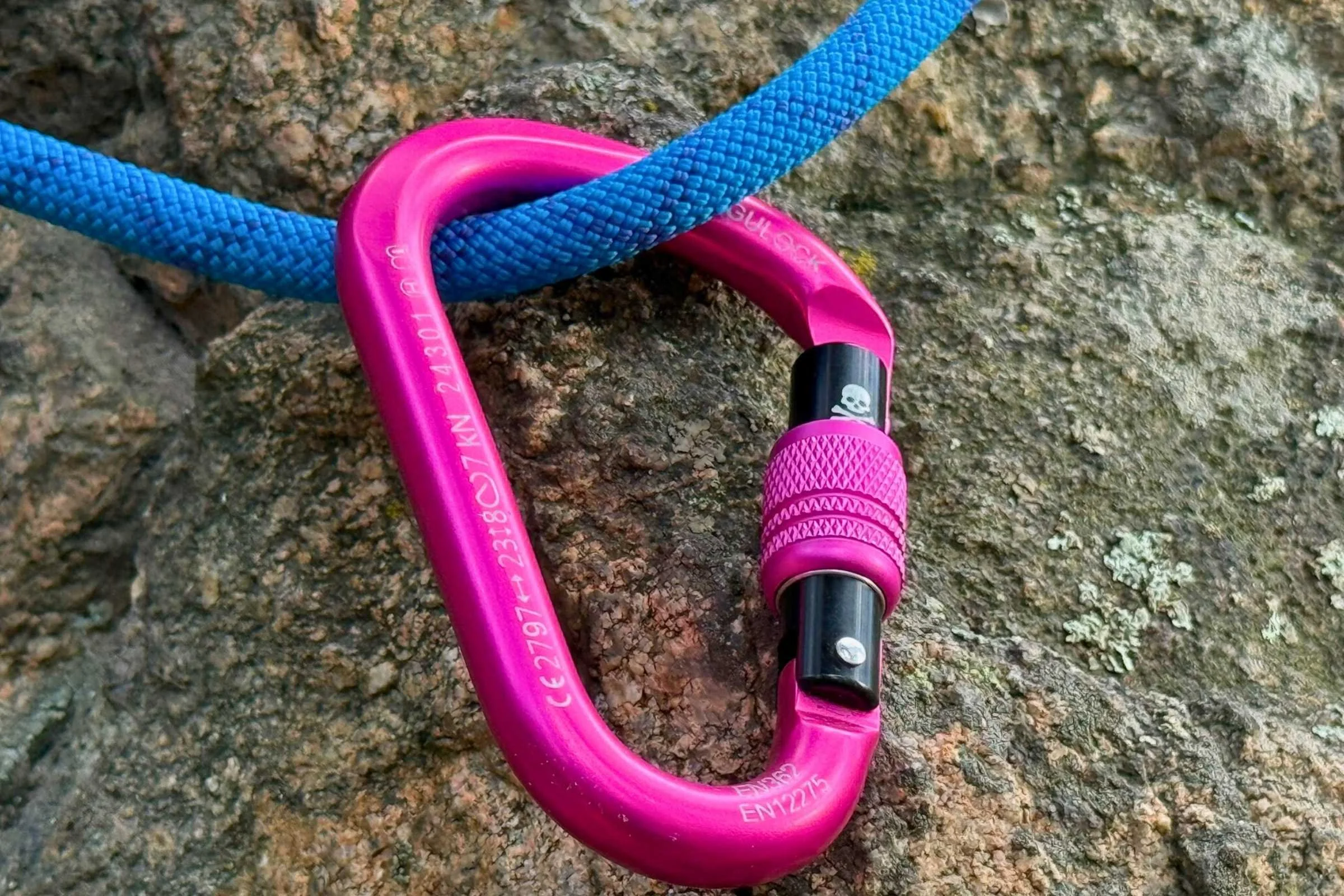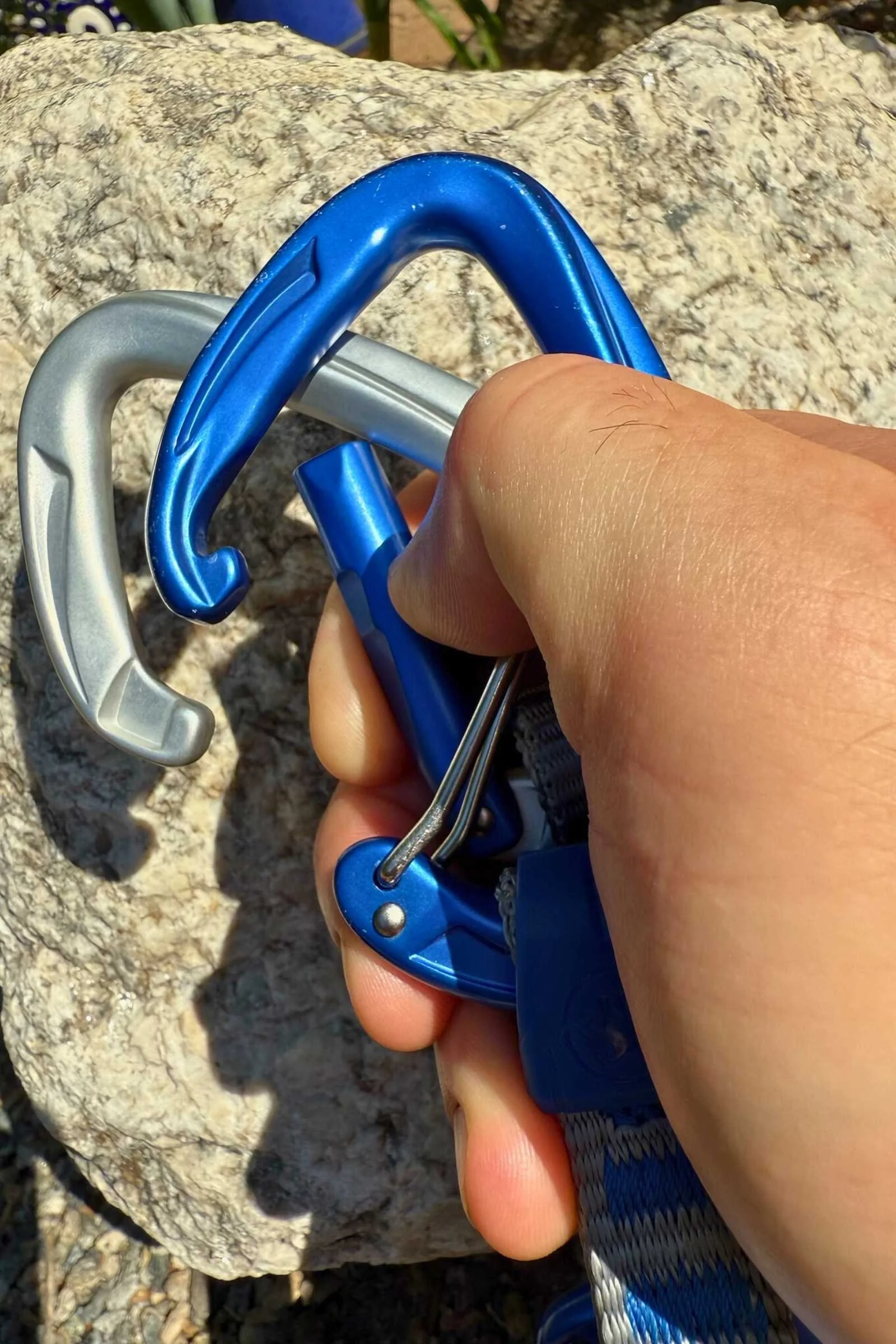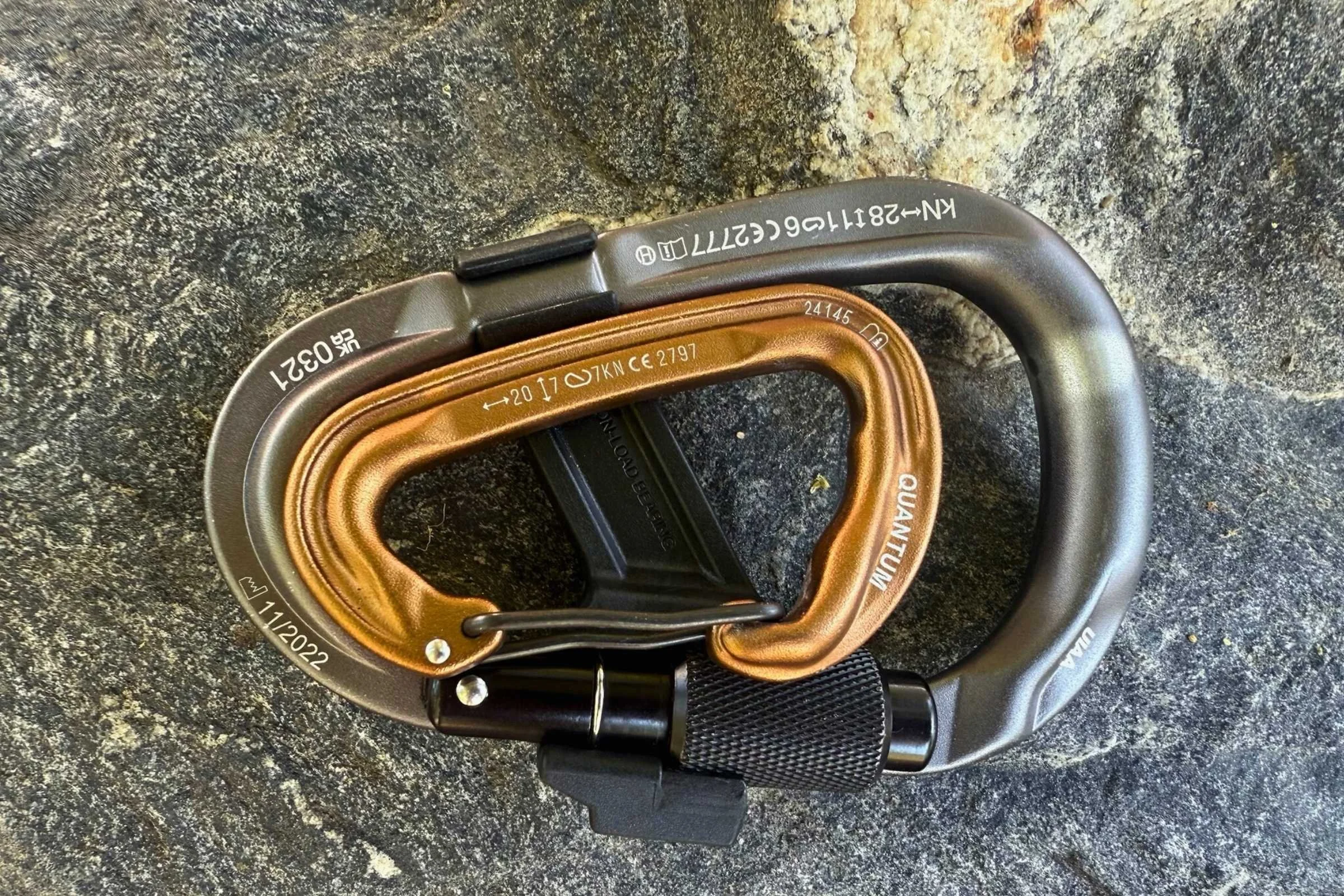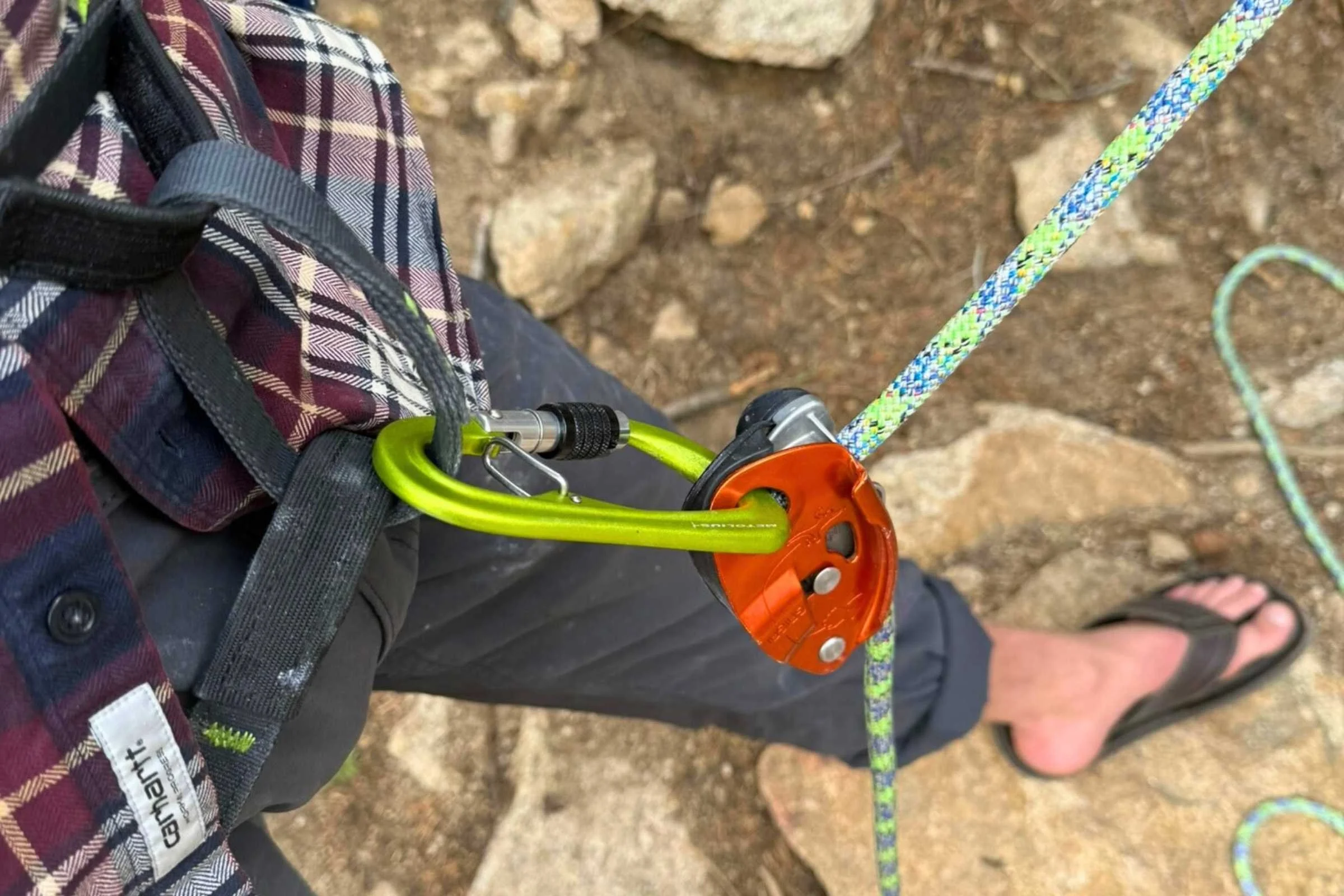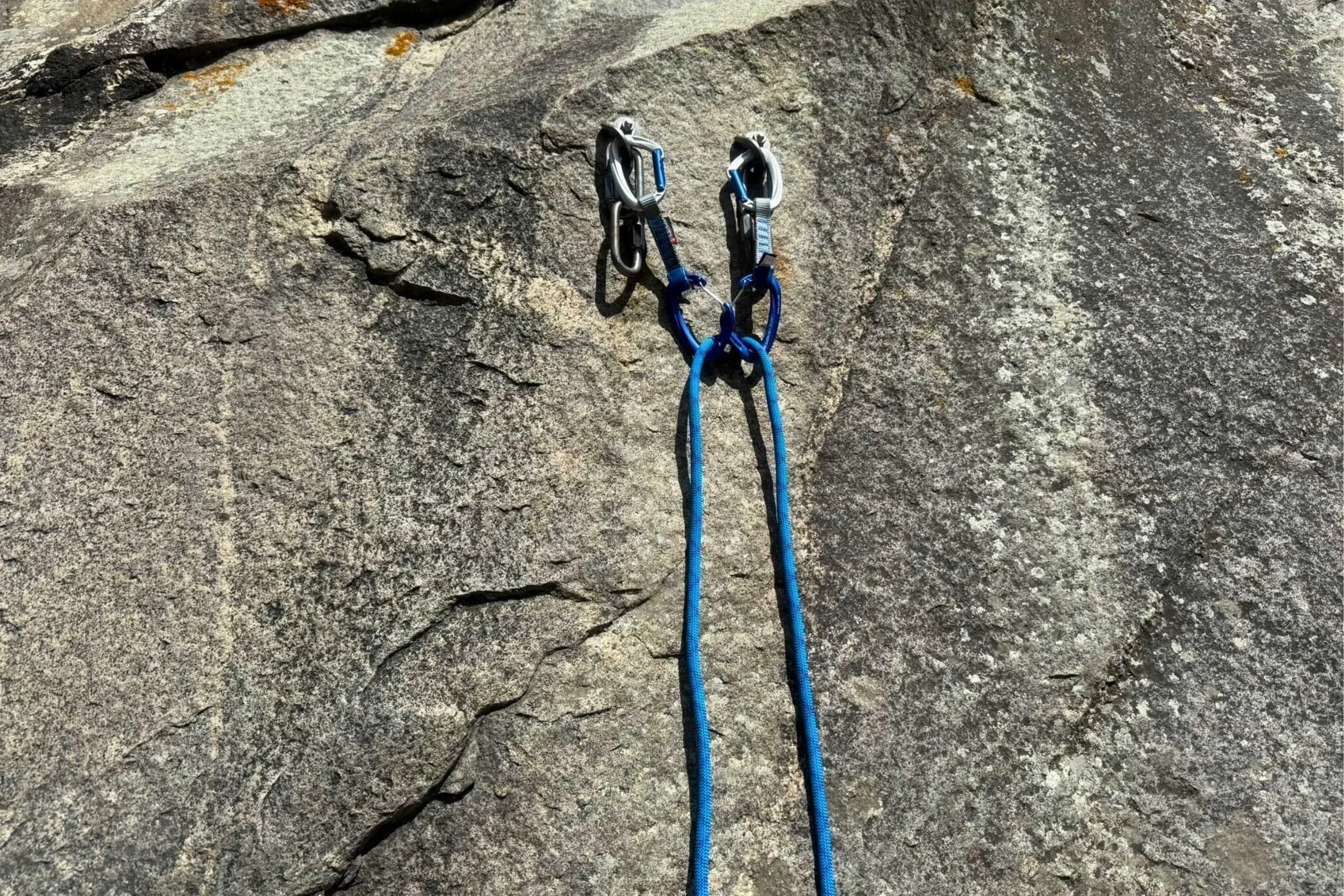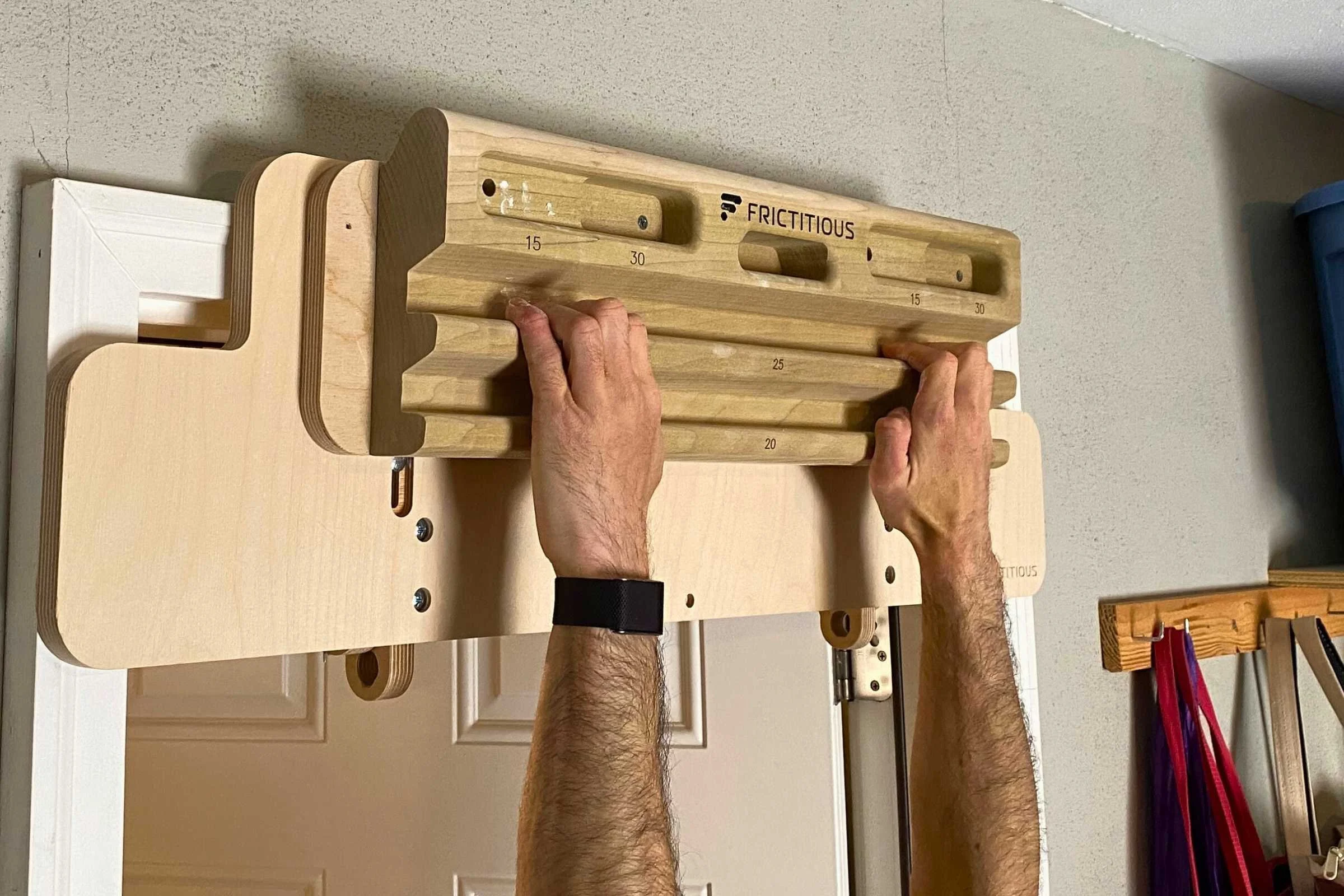Best Climbing Carabiners of 2025
Clip in with our top locking, auto-locking, wiregate, and belay carabiners for climbing
August 7th, 2025
Home → Gear Reviews → Climbing
Carabiners and locking carabiners, in particular, are among the most important gear in a climber’s arsenal and no, we’re not talking about the carabiner you use for your car keys to get to the crag. However, even one of these UIAA-rated lil’ suckers (as light as 19 grams!) could feasibly suspend a 3,900 pound Toyota Tacoma in the air when closed—not that we’d ever recommend that, but it would be interesting to see.
A locking carabiner is among the first pieces of equipment, along with a harness and belay device, that a novice climber needs to have to connect their belay device to their harness. More experienced climbers will need a variety of locking carabiners for different functions, like setting up an anchor, a PAS (personal anchor system), rigging up hauling systems, and more. Applications for locking carabiners are incredibly diverse and used by sport, alpine, ice, trad, and big wall climbers as well as mountaineers. They’re also used in rigging whitewater rafts, paragliding, sailing, canyoneering, as well as by arborists and a plethora of other applications.
In climbing, locking carabiners are used when climbers need additional safety and using two opposite and opposed carabiners isn’t ideal.
Carabiners are extremely important in climbing as well and are used in everything from securing gear and the rope with quickdraws or alpine draws to sometimes securing a chalk bag, water bottle, or belay or crack climbing gloves to the climber’s harness.
Over decades of climbing we’ve used climbing carabiners across the Colorado Rockies, the canyons of Utah and even classic climbing areas like Oregon’s Smith Rock and New Hampshire’s Rumney. Here’s what we’ve learned and everything you need to know about choosing the best carabiners for novice to advanced rock climbers.
We’ve probably used 100 different types of carabiners. For this guide we evaluated over 30 locking and non-locking carabiners and made our selections based on ease-of-use, size, type and purpose.
Related: Best Climbing Quickdraws
*Note: no matter what carabiners you end up purchasing, always make sure they carry the UIAA (International Climbing and Mountaineering Federation) stamp and meet the requirements of its 121 safety standard. Also, always purchase carabiners from reputable sources. There are numerous accounts of people purchasing counterfeit carabiners online and we know of one case over a decade ago where someone stole a bunch of demo pieces (only designed for a show) from a reputable brand and then tried to sell them. Don’t put your life at risk to save a few bucks! This rule extends not only to carabiners and climbing gear but also to climbing ropes and life-saving equipment like PFDs, for example.
We create reader-supported, mission-driven, objective gear reviews independently selected by our editors. This story may contain affiliate links, which help fund our website. When you click on the links to purchase gear, we may get a commission — without costing you an extra cent. Thank you for supporting our work and mission of outdoor coverage for every body! Learn more.
Comparison table
| CARABINER | TREELINE AWARD | TYPE | LOCKING? | GATE CLEARANCE | STRENGTH MAJOR AXIS CLOSED | STRENGTH MINOR AXIS | WEIGHT |
|---|---|---|---|---|---|---|---|
| Petzl Attache | Best Overall Locking Carabiner Read why |
Screwgate | Yes | 23 mm | 21 kN | 6 kN | 58 g |
| Black Diamond GridLock Screwgate | Best Overall Belay Carabiner Read why |
Screwgate | Yes | 21 mm | 22 kN | 7 kN | 76 g |
| C.A.M.P. Photon Lock Screwgate | Best Overall Screwgate Carabiner Read why |
Screwgate | Yes | 17 mm | 23 kN | 8 kN | 43 g |
| Petzl Ange L | Best Climbing Carabiner (Non-Locking) Read why |
Wire | No | 26 mm | 22 kN | 7 kN | 34 g |
| Petzl Ange S Wiregate | Best Climbing Carabiner (Non-Locking) Read why |
Wire | No | 23 mm | 20 kN | 7 kN | 28 g |
| Mammut Crag HMS Screwgate | Best HMS Carabiner Read why |
Screwgate | Yes | 27 mm | 25 kN | 10 kN | 80 g |
| Black Diamond HotForge Screwgate | Best Carabiner for Anchor Bolts Read why |
Twistlock | Yes | 18 mm | 24 kN | 8 kN | 50 g |
| Edelrid Pure Slider | Easiest Auto-Locking Carabiner Read why |
Auto-lock | Yes | 20 mm | 23 kN | 8 kN | 43 g |
| Petzl Sm'D Twist-Lock Autolock | Best Twistgate Locking Carabiner Read why |
Autolock | Yes | 20 mm | 23 kN | 8 kN | 51 g |
Video: Clipping Carabiners easiest to hardest
Clipping carabiners from simple to hard.
The winners
Best Overall Locking Carabiner: Petzl Attache Screwlock
Gate Type: Screwgate
Gate Clearance: 23 mm
Strength Major Axis closed: 21 kN
Strength Minor Axis closed: 6 kN
Weight: 58 g
What we liked: Most versatile size and shape, lightweight, great safety indicator
What we didn’t like: Easy to overtighten, not as durable as an HMS carabiner
Picking an overall favorite locker was tough. There are so many great options out there, but when it comes down to it, it’s hard to knock the Attache off this anchor. With its I-beam-style channels around most of the carabiner and thicker, rounder top, as well as its slightly offset-D/pear design, this is the most versatile, lightweight locking carabiner we tested. It’s light, thin, and just barely larger than some of the competition.
Petzl Attache Screwlock
We found it was easy to clip into most tight chains and bolts at anchors, thanks to the thinness and rounded angles. Yet, thanks to the pear shape, its basket also is large enough to serve as a master point as needed. The “If red, then dead” indicator on the screwlock gate is still one of the most visible ones out there.
No matter what level or type of climber you are, the Attache is a versatile locker that can be used for almost any situation. It’s at home at either end of an anchor setup, on your belay loop, at the end of your PAS or can serve as a masterpoint.
Best Overall Belay Carabiner: Black Diamond GridLock Screwgate
Gate Type: Screwgate
Gate Clearance: 21 mm
Strength Major Axis closed: 22 kN
Strength Minor Axis closed: 7 kN
Weight: 76 g
What we liked: Works with all belay devices, single gate belay keeping mechanism
What we didn’t like: No visual lock indicator
The tail of the unique gate on this anti-crossloading carabiner won us over compared to other belay-specific carabiners. We also loved that this locking belay keeper should work with every belay device. Some weren’t as capable.
Black Diamond GridLock Screwgate


Most other belay-keeping carabiners relied on a secondary mechanism to keep a belay device properly oriented. With the GridLock, when it’s open it automatically opens the secondary gate, or tail, so you can slide it off your harness’ belay loop. This is really great if your fingers are tired after a long day of climbing. We also like that since it’s part of the gate itself it’s much less likely to break than the secondary wire gates on other belay-specific carabiners.
We also like the smooth action of the screwgate. Although, we do wish Black Diamond included a visual locked indicator that many other screwgates we tested had.
Best Overall Screwgate Carabiner: C.A.M.P. Photon Lock Screwgate
Gate Type: Screwgate
Gate Clearance: 17 mm
Strength Major Axis closed: 23 kN
Strength Minor Axis closed: 8 kN
Weight: 43 g
What we liked: Ergonomic, easy to clip into tight spaces, quickest locking screwgate
What we didn’t like: Not big enough to serve as your daily masterpoint
If you’re looking for a versatile screwgate carabiner, there’s a lot of competition for the best. In the end we found that the C.A.M.P. Photon Lock screwgate was our favorite. That’s largely because it required the fewest turns to close, making it the quickest screwgate to close.
C.A.M.P. Photon Lock Screwgate
But it also had all the other features we’d want in a multipurpose locker. All color combos—we tested out the gorgeous, vibrant Janja version—made it easy to see whether or not the gate was locked with a warning sign on either side of the gate. The I-beam style construction made it fit well in all bolt, chain, and anchor situations, plus the thicker interior allows ropes and slings to slide more easily. It’s also more affordable than another top choice, the Petzl Attache, which was our pick for Best Locking Carabiner.
Best Climbing Carabiner (Non-Locking): Petzl Ange L and Ange S
Gate Type: Wire
Gate Clearance: 26 mm
Strength Major Axis closed: 22 kN
Strength Minor Axis closed: 7 kN
Weight: 34 g
What we liked: Lightweight, two size options, not prone to fouling up with dirt or ice
What we didn’t like: Only two color options for each the small and large, other wiregates are less expensive, doesn’t come in rack packs
There are so many great options for carabiners out there and most climbers are less picky about carabiners than locking carabiners, but in the end only one we tested really put together the best elements of a keylock nose and a wiregate carabiner, and that’s the Petzl Ange L and Ange S.
Petzl Ange L and Ange S
Petzl Ange L
Petzl Ange S
The unique MonoFil gate is a thick, single-wire post that nestles into the nose like a reverse keylock. When open there’s no hook to get stuck on. The MonoFil gate and keylock system also make it harder for ice to lock the gates up during wintry adventures since there’s less area for water to freeze on.
The plastic guard at the base of the gate makes it easier to grasp and helps guide the carabiner onto a rope or bolt. Similarly, bumps on the basket and runner end across from the spine help keep the carabiners lined up in the right direction when weighted.
Both the large (34g) and small (28g) are among the lightest carabiners we tested. While within the price range of other premium carabiners, if they weren’t twice the price of wiregate carabiners like the Camp Photon, we’d be using these on all of our trad draws.
Best HMS Carabiner: Mammut Crag HMS Screw Gate
Gate Type: Screwgate
Gate Clearance: 27 mm
Strength Major Axis closed: 25 kN
Strength Minor Axis closed: 10 kN
Weight: 80 g
What we liked: One of the biggest open gates we tested; plenty of basket space; and easy to handle, lock and open; good price for an HMS locker
What we didn’t like: No lock indicator
We only tested a handful of HMS carabiners and all were effective. However, in the end the Mammut Crag HMS won out. It’s slightly lighter than the Trango Regulock we tested at 80g vs. 87 g and has a wider open gate at 27 mm than the Regulock at 22 mm. That makes it easy to access the 75 mm of space on the basket for managing all the gear you may clip in on a masterpoint or to use with a Munter hitch.
Mammut Crag HMS Screw Gate
With some indents to save weight throughout the carabiner body, the carabiner is easy to grab and operate one-handed. The Crag HMS only required 3.75 rotations to close as well, making it almost as quick to lock and unlock as the Black Diamond RockLock Twistlock auto-locker we tested, yet more secure.
We could use this piece of gear in most situations while climbing. It has a thinner profile than most other HMS carabiners we tested, so we could use it in some situations where a bolt or chain is tight. But we’re usually going to use it in a situation where we’d need to manage multiple climbers on an anchor, and or haul gear on it. The carabiner has more material than a smaller locker, so it should easily last for years, even if used to belay with a Munter hitch.
Best Carabiner for Anchor Bolts: Black Diamond HotForge Screwgate
Gate Type: Twistlock
Gate Clearance: 18 mm
Strength Major Axis closed: 24 kN
Strength Minor Axis closed: 8 kN
Weight: 50 g
What we liked: Compact and narrow, stays properly oriented, light
What we didn’t like: No lock indicator, thinness means it may wear quicker than other options
This small, medium-sized, screwgate I-beam style carabiner is ideal for clipping into sport anchor bolts and chains. The narrow design makes it easy to clip into tight spaces where a round or HMS carabiner might not slip in easily. The angle between the basket and spine is somewhat sharp, which helps properly orient the carabiner and reduces the likelihood of it being cross loaded while in use.
Black Diamond HotForge Screwgate
The carabiner is light and small but still easy to use—even for larger hands. We also appreciated the smoothness of the screwgate even though it took more rotations to close than some others we tested. Still, this is the locker we’d use everyday on our sport anchors.
Easiest Auto-Locking Carabiner: Edelrid Pure Slider
Gate Type: Auto-lock
Gate Clearance: 20 mm
Strength Major Axis closed: 23 kN
Strength Minor Axis closed: 8 kN
Weight: 43 g
What we liked: Easiest to use locker, light weight and good shape
What we didn’t like: Also easiest to defeat while locked, thinner body means it will wear quicker than other lockers
We wouldn’t be surprised if you didn’t realize the Edelrid Pure Slider is a locking carabiner at first glance. It’s the lightest locking carabiner we tested as well, as light as some of the carabiners we tested in quickdraws.
Edelrid Pure Slider
With the exception of the sliding lock mechanism on the top of the gate, it looks like a solid-gate carabiner. We also found it was the easiest and most intuitive locking carabiner to use. Slide the locking gate down a few millimeters and push and it’s open. Let go and it instantly snaps into place, locked.
Defeating the Edelrid Pure Slider in just a few seconds.
We’d feel safest using this to clip into the rope or in other places where the locking mechanism isn’t likely to rub against anything tight or hard, like the edge of a bolt. We were able to easily defeat the mechanism that way (see video!)—it’s still unlikely, but something to be aware of. Still, in an application where the locker isn’t likely to rub against anything, these provide a lot of extra safety and relief over a normal carabiner.
Best Twistgate Locking Carabiner: Petzl Sm’d Twistlock
Gate Type: Autolock
Gate Clearance: 20 mm
Strength Major Axis closed: 23 kN
Strength Minor Axis closed: 8 kN
Weight: 51 g
What we liked: Good locking gate action, great size and shape, light
What we didn’t like: Not big enough to work as an HMS, still not as robust as a screwgate or triple-action locker
The Petzl Sm’d Twistlock is another great lightweight locking carabiner that’s easy to use. Simply twist the well knurled sheath and push the gate back against the spine and it’s open. Let it go and it immediately snaps back into place. The recesses in the sheath make it easy to use even with gloves. As a two-stage autolocker it’s still a little less secure than a triple autolocker, but we found it pretty hard to defeat in most circumstances. It was harder to defeat than the twistlocks on the Black Diamond twistlocks as well.
Petzl Sm’d Twistlock
In size, it’s larger than smaller lockers like the Black Diamond Hot Forge Screwgate, but it’s smaller than the Petzl Attache. The size, shape, and design of the Sm’d make it ideal for using in anchors, PAS systems, and many other situations where you need a do-it-all locker. But it’s not big enough to use as a masterpoint in circumstances where you’re belaying with a Munter or have multiple people on the same point.
Best Carabiner Rack Pack: Trango Phase Rack Pack
Gate Type: Wire
Gate Clearance: 19 mm
Strength Major Axis closed: 24 kN
Strength Minor Axis closed: 8 kN
Weight: 30 g (single)
What we liked: Great value, easy to clip wiregate carabiner, pack of six colors
What we didn’t like: No black or grey Phase rack packs available, no orange carabiner
Rack packs are a great way to add important pieces to your collection of climbing gear. The Trango Phase Rack Pack offers a lot of value for those building out a trad rack or those who want to color code other certain aspects of their climbing gear.
Trango Phase Rack Pack
The Phase is a solid performing, lightweight wire-gate carabiner that’s ideal for using in trad and alpine draws, or for connecting gear to your harness, like a chalk bag or a rock cleaning brush. It’s an easy to use mid-sized hook nose carabiner that wasn’t prone to snagging on anything.
It’s relatively inexpensive when purchased alone (usually less than $8) and in a rack pack of six each carabiner is closer to $7 a carabiner.
Other climbing carabiners we tested
We tested, used and considered an almost overwhelming number of carabiners and locking carabiners for this piece—well over 20. There are many we loved that were edged out by others in our testing. And some, not so much. Here are notes on some of the other carabiners and locking carabiners we considered for this piece.
Gate Type: Twingate
Gate Clearance: 24 mm
Strength Major Axis closed: 30 kN
Strength Minor Axis closed: 11 kN
Weight: 69 g
The author has used this Twin gate locking carabiner (technically its predecessor, the HMS Twin Gate Carabiner) for over a decade on his anchors and PASs. We wanted to award it as the best auto-locker for ice climbing since it’s harder for ice to form on the twin gates than on screwgates and most auto-lockers. However, they’re hard to find now and at least one site, weighmyrack.com, lists it as retired and it’s not listed on Grivel’s site as of July 2025.
Grivel Lambda K7G HMS Twin Gate Carabiner
Gate Type: Screwgate
Gate Clearance: 21 mm
Strength Major Axis closed: 24 kN
Strength Minor Axis closed: 7 kN
Weight: 77 g
We really liked this belay keeper from Wild Country. However, the simplicity of the gate on the Black Diamond GridLock edged this out. We found that this belay keeper was easy enough to clip into a harness and unclip from a belay loop, since you can just slide it out of the bottom gate when you want to take it off. Other models require you to push up on a bottom gate to unclip it from the belay loop. Usually not a big deal unless your fingers and forearms are totally spent. This is our second best choice for a belay carabiner.
Wild Country Xenon HMS Belay
Gate Type: Autolocker
Gate Clearance: 24 mm
Strength Major Axis closed: 24 kN
Strength Minor Axis closed: 8 kN
Weight: 89 g
This HMS Pear autolocker is a good option, but we liked the twistlock on the Petzl Sm’d better. The knurls on this aren’t as well defined and may be harder to operate in the winter with gloves. Also, it didn’t feel quite as crisp or snappy as the Petzl.
Black Diamond RockLock Twistlock
Showing how cumbersome the Mammut Smart HMS 2.0 Screwgate is to rack with a GriGri.
Gate Type: Screwgate
Gate Clearance: 27.5 mm
Strength Major Axis closed: 28 kN
Strength Minor Axis closed: 11 kN
Weight: 93 g
We really like this belay keeper locker…for ATC or tube-style belay devices. It’s really easy to tell when it’s locked in place properly, and with an ATC it racks up just fine. However, it doesn’t play nice with belay devices like the Petzl GriGri—one of the most popular options, making it hard to recommend as a best pick.
Mammut Smart HMS 2.0 Screwgate Carabiner
Gate Type: Screwlock
Gate Clearance: 22 mm
Strength Major Axis closed: 25 kN
Strength Minor Axis closed: 8 kN
Weight: 87 g
This was a contender for our HMS/Pear carabiner. But it fell short of our favorite pick, the Mammut Crag HMS carabiner, in a few ways. It had a smaller open gate, was heavier, and though we loved the locked indicator, skull and crossbones and all, we noticed that it was only on one side of the gate.
Trango Regulock Screwlock
Gate Type: Wire
Gate Clearance: 26.5 mm
Strength Major Axis closed: 27 kN
Strength Minor Axis closed: 8 kN
Weight: 38 g
This is a great carabiner, and like the Trango Phase quickdraws, it’s available in rack packs. However, they’re just a little more expensive than the Phase at the time of writing.
Wild Country Wildwire
How to choose climbing carabiners
How can a device forged out of aluminum that can weigh less than a pair of sunglasses be strong enough to suspend a midsize truck? Time, engineering, standards and refinement.
The first modern karabiners or snap links used in alpinism were made of steel and go back to at least the late 1800s. Most modern climbing carabiners are now made of hot or cold-forged aluminum alloys, making them highly corrosion resistant while lightweight and, when used properly, incredibly safe for climbing.
Here’s everything you need to know when choosing locking and non-locking climbing carabiners from their various parts like the gate and nose to the tolerances and shapes, and why they all matter.
Anatomy of a carabiner.
Parts of a carabiner
Most modern carabiners have five main features: four on the main body of the carabiner and the last on the gate or opening of the carabiner. The gate itself has a number of features as well, but we’ll get into that below.
The strongest, longest part of a ‘biner is its spine, the length of metal on the opposite side of the gate. The widest part of the carabiner is called the basket and is usually considered the top of a carabiner since it sits above the nose. The basket is where you usually want your rope or protection to sit on a carabiner, since moving freely across this surface helps reduce wear and orients the carabiner in its strongest positions.
The nose of the carabiner is the part that interacts with the gate of the carabiner. When closed it helps impart strength to the carabiner and makes it operate more like a link in a chain. There are a number of different types of noses used in carabiners depending on the type of gate used.
The spring loaded gates of carabiners make it easy to clip and unclip to all the various climbing equipment you’ll use, from from your harness and belay device, to the rope, slings, quickdraws, bolts or trad protection, and more. Once they snap shut the carabiner is at its strongest. Gates come in many different styles and feature the locking components of locking carabiners.
The last component of a carabiner is the runner end, the narrowest part of a modern carabiner through which a runner, sling, or the dogbone component of a quickdraw is attached.
When oriented and used properly the weight of the climber, belayer, and any climbing equipment is on the top and bottom of the spine in the basket and in the runner end.
Types of carabiners
There are two main types of carabiners, locking and non-locking. Locking carabiners have one or several mechanisms, like a screw gate, that allow you lock the gate of the carabiner off so it’s even more impervious to opening (and therefore being in a weak orientation) or even worse, unclipping from whatever it’s attached to than a non-locking carabiner.
Shape
Older oval climbing carabiners were essentially “0” shaped–the tops and bottoms were the same, so an oval carabiner is equal at each end. Then climbers moved to a “D” shaped carabiner with equal top and bottom baskets that helped orient the rope, slings and attachment points, like bolts, towards the spine of the carabiner.
Offset D
Most modern climbing carabiners use an offset “D” construction with a distinct basket and runner end as mentioned above. This makes it easier to use the strong top and bottom parts of a carabiner. HMS and pear carabiners are sometimes shaped as offset D carabiners.
HMS or pear carabiners
HMS and pear-shaped carabiners are among the largest used in climbing. HMS stands for Halbmastwurfsicherung, which is the German term for using a Munter hitch, which requires a lot of space on the basket of a carabiner. If it helps the author thinks of HMS as meaning “high mass style”, since they’re both larger than many other carabiners and given their rounded shape, they often are thicker since the shape isn’t as strong as a D-style carabiner.
These carabiners are usually lockers used in belaying, repelling, and hauling gear as the wide basket and often rounder construction of the basket make it easier for the rope to move back and forth as you do with a Munter hitch. The shape is more pyramidal and not offset but the carabiner still has basket and a runner end, allowing rope and other equipment to center on the strong points. The carabiners usually have a straight spine, but some have a slight curve, furthering the likeness to a pear. Given their size and thickness they’re not the carabiner you’d want to use to attach to bolts or rings on a route.
Examples of different carabiner gates: from L-R, four different types of autolockers, a screwgate, and a regular carabiner.
Gate type
The gate is the part of the carabiner that opens up and springs closed on its nose, making the closed carabiner stronger than an open one. It allows climbers to securely clip the carabiner to whatever they need to. Perhaps the most noticeable technology on a carabiner, and locking carabiners especially, is found in the gate.
For the UIAA to certify a carabiner under its 121 safety standard, the gate must open to at least 15 mm. That’s larger than the thickest climbing rope we tested, the 10.5mm thick DynaGym rope. Generally, a larger gate makes it easier to connect a carabiner to climbing gear. However a too-large gate opening can make handling a carabiner with one hand unwieldy. Particularly for those with smaller hands.
In regular carabiners, some gates are solid pieces of metal while some are made of wire. Some gates are straight and others are bent. The straight gates are generally designed for clipping into bolts and anchors. The bent gates are designed to make it easier to clip into a rope while holding the spine.
Both gate designs have pros and cons. Wire gate carabiners are generally lighter than solid-gate carabiners and the design of wire gate carabiners make them less likely to flutter than solid-gate carabiners. However, the nose design of most wiregate carabiners makes them more likely to snag on a rope orbit.
The classic locking carabiner is a screwgate. However, there are a ton of locking carabiners that are called auto-locking. This means as soon as the climber lets go of the gate, the carabiner automatically moves to the locked position.
Mammut uses both a keylock nose (silver) and a hook nose (blue) on its Crag Keylock Wire Indicator quickdraws.
Nose
The nose of the carabiner is where the gate rests when closed, making the carabiner stronger and when stressed during a fall it's designed to lock the gate in place. There are two main styles of noses on a carabiner: keylock and hooked.
Keylock carabiners are found on many solid gate carabiners. Some solid-gate carabiners use a pin on the gate and a hook-nose design. Most wiregate carabiners use a hook nose design. The unique Petzl Ange carabiners are considered a wiregate carabiner but have a keylock-type nose, thanks to a single, thick wire with a bulbous end.
The hook nose design is easier to make as keylock noses and gates require more precise forging and tolerances, making them more expensive. However, the hook on the nose is more susceptible to snagging on a rope or bolt. To help reduce this, manufacturers continue to refine and revise their hook designs and some have made what they called clean noses to reduce any possibility of snagging on ropes and other gear.
Locking carabiners
Locking carabiners, also simply referred to as lockers, are designed for extra security. They have a mechanism that locks the gate in place on the nose of a carabiner and are used for a number of important things in climbing where a climber wants more assurance than a simple carabiner, like connecting a belay device to the harness and to the climber’s rope, a PAS from the harness to the anchors, and connecting to anchors and ropes at the anchor. There are two main types of lockers: screw gates and auto-lockers.
Screwgates are the OG—they’re simple, reliable and available from almost every manufacturer. There are a number of different types of auto-lockers including double and triple action auto-lockers. Most of these require the user to make two or three movements with their hands to unlock. The three-stage auto-lockers are considered the safest but are often more complicated to operate.
The Quantum was both the smallest and lightest in our test samples and nests inside the Mammut Smart HMS 2.0 Screwgate, the largest and heaviest tested.
Weight and size
The heaviest and largest carabiners we tested were HMS carabiners like the Mammut Smart HMS 2.0 Screwgate Carabiner, which weighs 96 grams and is 77 mm at its widest point on the basket and 119 mm at its tallest point. By comparison, the smallest carabiner we tested was Trango’s Quantum carabiner, which weighs 24 grams and measures 77 mm at its tallest point and 46 mm at its widest point.
The majority of carabiners we tested were between 28 and 40 grams in weight. Wire gate carabiners were lighter than solid gate carabiners. The lightest locking carabiners were about 46 grams.
Measuring different aspects of carabiners and quickdraws.
The majority of carabiners we tested were between 50 and 60 mm at their widest and around 100 mm at their tallest.
As climbers’ ambitions and pursuits grow and change, they’re going to need a variety of locking and non-locking carabiners. For pure alpinists, and multi-pitch trad climbers, using thinner ropes and carrying as light and little gear as possible, smaller, lighter carabiners and lockers are ideal. However, the smallest, lightest carabiners have less material and will wear out quicker after use.
Big-wall climbers want durable carabiners and lockers that can stand up to the rigors of repeated thousand foot climbs. Sport climbers also want durable carabiners and even if they’re doing multi-pitch routes the emphasis doesn’t necessarily need to be on the lightest carabiner, ever.
Strength ratings shown on multiple carabiners. From left to right on each: Strength along the spine; strength when cross-loaded (force on gate and spine); and with the gate open.
Strength ratings
Carabiners that meet the UIAA 121 safety standard are measured for strength in terms of kilonewtons (kNs), which measure the force of weight falling. They’re also tested in numerous positions to find out how the device stands up in the best case scenario with the gate closed, and the top and bottom aligned with weight on the major axes. They’re also tested in the worst case scenarios cross-loaded with weight on the spine and gate (minor axes), or weighted with the gate open.
The ratings are stamped or printed on the side of each UIAA-approved carabiner and marked with symbols showing the strength of the carabiner in all three positions. The major axis must handle at least 20kN and the minor axis at least 7kN. With the gate open HMS carabiners have to handle at least 6kN, while other carabiners have to handle 7kN in this position.
Given that 1kN is equal to the force of about 100 kilograms falling or 224 pounds of force it's easy to see how every carabiner could lift a midsize truck on its major axis since 20kN is equal to 4,496 pounds of force. While many carabiners tested met the minimum ratings, some, like the Grivel Grivel Lambda 7G with major axe rating of 30kN and a minor axis rating of 11kN far exceed those minimums.
Ease of use
Wire gate and solid gate carabiners have similar applications and are generally easy to use. After using dozens of models over the years, we’ve come to prefer carabiners with more rounded angles around transitions (think from the spine to basket or nose to basket) are generally the easiest to clip with and least likely to snag on anything. If you’re using a thick workhorse rope, you’ll want to work with carabiners with larger gates. If using thinner ropes, like twin ropes or alpine ropes, working with smaller carabiners and smaller gates is fine.
However, smaller carabiners and gates are harder to work with while wearing gloves. So, for ice climbers and mountaineering objectives in cold conditions, mid-sized carabiners and bigger are more ideal.
Beyond looking for carabiners with a less angular structure, we found that the hook nose on some carabiners can, in some cases, snag on a rope or bolt. Look for carabiners with smaller, protected, or shrouded hooks to help avoid this. This is usually a non-issue with keylock noses, since they don’t have a hook to snag. But with wire gate carabiners it is still sometimes an issue.
Various screwgate lockers with and without safety markings. The blue Mammut locker on the left has no marking and the red nail polish on the Black Diamond with a green screwgate was applied by the author.
The best locking carabiners make it easy to tell when the carabiner is locked. For instance, Petzl introduced a red marking on the gate that is covered up when the gate is fully closed. Other manufacturers have followed with either a similar red mark or a caution indicator or something else—Trango’s Regulock has a skull and crossbones when the screwgate is down. With auto-lockers, since they lock automatically, they don’t need a similar indicator.
The most important thing with buying and using any locking carabiner is making sure you’re comfortable with using it one-handed in a dicey situation, since you might have to use it to clip into a bolt or chain while in a precarious position, like with one hand on a sloper and only one decent foothold—or none at all! We recommend you practice locking and unlocking the carabiner—with both hands—at home or at work.
With screw gate lockers, make sure you’re comfortable with how many rotations you need to close the locker. It may seem silly, but there's a big difference between the 2.75 rotations it takes to close the C.A.M.P. Photon Lock and the 5 rotations it takes close the Metolius Gatekeeper screw lock carabiner.
A Metolius Gatekeeper Belay Carabiner on the harness.
When it comes to auto-lockers, the double-action lockers like the Black Diamond Rock Locker are easy to use and almost as quick to twist open as a non-locking carabiner, yet provide the security of a locker. They’re fine for most situations but we really like the extra security of triple-action lockers—even if they’re a little more fiddly—for some of the most critical applications, like securing our PAS to the anchor.
Intended use
Carabiners and locking carabiners have distinct uses when it comes to climbing. While some uses can overlap, a basic way to think about it is you want to use carabiners in places where your life is less dependent on them and moving quickly is paramount to achieving your climbing goals. You want to use locking carabiners at points where an inadvertent gate opening could lead to a fall, injury, or death for you or your climbing partners.
Other than using carabiners to attach things to your pack or harness you’ll want to use carabiners for quickdraws, alpine draws, and trad gear–situations when you’re actively climbing. In these situations if you fall on the gear you placed you might get injured if something fails, but it shouldn't be a catastrophic injury.
If you’re primarily or only sport climbing outdoors you might want to just purchase quickdraws rather than build out a bunch of them piece by piece. It’s usually cheaper and you get the draws you would have purchased separately anyhow.
Lockers, on the other hand, should be used anywhere that you need extra redundancy for you and your climbing partners. This includes securing your belay and rappelling devices to your harness and rope. You should also use a locking carabiner on your PAS when anchoring in at the top of a climb.
One of the author’s pre-made sport anchors.
An anchor made with two quickdraws.
Two opposite and opposing quickdraws with regular carabiners on an anchor is one way to anchor in. But many climbers still use a sling with lockers to connect to the anchor bolts or chains. This allows for more flexibility in creating and using a master point and shelf, which is necessary for longer, multi-pitch, and big wall climbs.
Lockers should also be used when making anchors with slings and webbing slung around trees, rocks, and boulders.
How to use different types of carabiners and lockers
In most cases the offset D shape is the best option for climbing. HMS and pear carabiners are also important to have for certain situations.
Solid gate carabiners
These OGs are best suited for sport climbing situations and probably best employed on the bolt or anchor side of a quickdraw.
Wire gate carabiners
These wiry upstarts are actually kinda old now, considering Black Diamond introduced the first wire gate climbing carabiner, the HotWire, in 1995. But they offer some advantages over solid gate carabiners and are more versatile.
The wire gate makes them less likely to get frozen in inclement weather, so they’re more ideal for alpine and ice climbing. They’re lighter than straight gates and they’re less likely to suffer from gate flutter when they smack against a rock. Their only real disadvantage compared to solid gate carabiners is that some hook noses can snag on a rope or bolt. That said, they’re ideal for quickdraws, alpine draws, and trad draws.
A bent gate carabiner on the top and straight gate on the bottom.
Straight vs. bent gates
Both wire and solid gate carabiners are offered with straight or bent gates. While they are interchangeable, straight gates are more ideal for clipping to a bolt, while the curve of a bent gate makes it easier to slide the rope into the basket of the ‘biner.
Treeliners trying to figure out autolocking carabiners.
Screwgate locking carabiners
The OGs of locking carabiners, screw gates, are useful anywhere you need the extra security of a locking carabiner. They do take a little more time to close and operate than many auto-lockers, so make sure you’re comfortable with the time it takes to fully lock and unlock the gate of any screw gates you use.
Double-action locking carabiners
These are quickest locking carabiners and easiest to operate. Most need just a half twist and a push on the gate to open. They’re great for situations where speed is paramount, like connecting a sling anchor to anchor bolts or the rope to the anchor.
Triple-action locking carabiners
These are the most secure auto-lockers. However, they’re a little more fiddly to operate than double action locking carabiners but they’re still usually faster to reply than screw gate lockers. With these types of lockers users have to complete a combination of movements to open the gate, this usually includes pushing up on the gate sleeve and then twisting it. With these lockers it’s far less likely that anything could unlock them than even a double auto-locker. These are best suited for belaying and PAS systems.
Speciality lockers (belay keepers, etc.)
There are also an increasing number of specialty lockers out there, most of which are known as belay keepers. These carabiners may have a unique shape, like the exaggerated pear head of Black Diamond’s Gridlock Screwgate, but they have a great purpose. They have a mechanism inside the carabiner that secures to the belay loop on the harness that makes it almost impossible to cross load the carabiner while belaying or rappelling. Depending on the make and model it may be an auto-lock or screwgate locker.
Shape, size, weight
The shape, size and weight of a carabiner also impacts how you’ll use it. Offset D’s are the most ubiquitous and useful carabiners in climbing. However, HMS and pear lockers are also an important part of a climber’s kit as they become more advanced.
When it comes to draws of all types (alpine, sport, trad) offset Ds are carabiners of choice. Their design makes them easy to grab, clip in to bolts and ropes as well as unclip. They are also relatively self-orienting with the spine aligned to the main pulling force.
We think most people will prefer medium-sized carabiners for their draws, no matter the type of climbing. For those who want to go fast and light, they can opt for smaller, lighter draws and carabiners like Trango’s 52.5 gram Quantum quickdraw with the Atomic dogbone. However, the small carabiners are harder to rack and place, especially for larger hands or when wearing gloves.
When climbing with bolted anchors a small mid-sized, thinner offset D locker is our go to for anchoring into the chains, bolts, or rings, like the Mammut Sender Screwgate or the Black Diamond VaporLock Twistlock. These smaller and thinner lockers can fit in and be more manipulated in a tight space than bigger, thicker lockers like HMS lockers.
On the other end of our anchor sling we ideally use two opposite and equal mid to large-sized lockers on different strands of the sling to easily accommodate any size rope. We’ll often use offset D carabiners for this but on a dedicated sport anchor we’ll use a HMS or pear as a thicker, heavier locker should last for years of rope drag. If we’re going on multi-pitch or trad climbs we may swap those out for lighter lockers to save a little weight.
When creating a master point we opt for HMS lockers. These have enough space to accommodate one or more PASs as well as a rope with a clove or Munter hitch if needed. Lighter is nicer, but again, a heavier HMS with more material, like the Trango Regulock will last longer in this service.
While we’re not as well versed in aid climbing, HMS and pears are also quite useful in connecting to gear like ascenders, portal edges, and more.
Carabiners color-matched to the slings of cams make it easier to find the right one on a rack.
Color
Color is often a preference when picking carabiners. But there are reasons why you’d want specific colors like those in Trango’s Phase Rack Pack. Particularly when trad and alpine climbing. When building your alpine draws with slings you may want one grey or black carabiner on the side you plan to use to clip into your protection and a colored one (you and your partner’s choice, but yellows and blues are the most visible for most people).
Alpine and trad climbers will also match the colors of their cams to the carabiners on the cam slings. This helps with climbing efficiency by making it easier for them to find the right cam for the right placement.
Care and maintenance tips
Everything has an expiration date, but yours should never be because you used climbing gear past its expiration date or useful life.
You should always check climbing equipment for wear and tear every time you use it and also check it after any big climbing falls or if the equipment experiences a significant fall. Normal wear, like the anodizing coming off carabiners, is fine. Over time carabiners, especially those used for the rope at anchors, will experience wear and will groove the carabiners. As the groove deepens the ‘biner weakens and should be retired.
Also inspect your carabiners for any burrs or sharp points caused by the edges of bolts, rubbing against sharp rocks, or accidentally getting hit by an ice axe or crampons. These burrs can quickly ruin a rope or sling and cause a catastrophe while climbing.
Whether it's a locking or non-locking carabiner, you should also make sure the gate and spring are working properly. One of the best ways to check this is by simply opening the gate and making sure it feels as snappy as other carabiners of the same make and model. If the gate doesn’t fully close on the nose or if it feels sticky you can try to clean it—but it may be on its way to retirement. With screwgate and auto-locking carabiners, take the additional step to make sure the locking mechanisms work smoothly. If the gate or body of the carabiner is noticeably bent or damaged for any reason, it’s definitely time to retire it.
With normal use, carabiners should last years without needing much maintenance. If you climb in a salty environment, like an ocean crag, or if you find you’re often dropping carabiners in the dirt, they’re more likely to need some TLC from time to time. Try compressed air to blow anything out around the gate, spring, and hinge, or soaking them in soapy water and rubbing them with a brush and then rinsing them.
Though you shouldn’t need to do it often, you can also apply a very small drop of lubricating wax or oil on the hinge and locking mechanism of the carabiner. Manufacturers recommend different things. Some, like Edelrid, advocate for using an oil with Teflon, like Tri-Flow, while others advocate for a lubricating wax, like Metolius’ Cam Lube. Either way, after lubricating the hinge, spring, and gates, wipe off any excess lubricant with a rag. If the carabiner is still sticky or doesn’t properly close on the nose after cleaning, retire it to other uses like clipping something to your pack, using them around the house to hang things, or recycle them.
How we researched and tested
While we’ve climbed from the east coast to the west coast, the Colorado Rockies and the Front Range are the author’s home base and most of the climbing for in-field testing was done in Clear Creek Canyon, Rocky Mountain National Park and Boulder Canyon.
Beyond the author using the carabiners, he put them in the hands of other Treeline Review testers as well as climbing buddies. These included both experienced and inexperienced climbers (and both left-handed and right-handed testers). With locking carabiners, especially auto-lockers, we evaluated them for one-handed operation with both hands.
We also evaluated locking carabiners for the likelihood that the locking mechanism could unlock in a situation—however unlikely. With screwgate carabiners we considered how many rotations it takes to fully lock the carabiner. We even considered adverse conditions like how snow and ice could impact the use of the carabiner. For instance, we’ve found solid gates are more likely to get fouled by snow and ice than wire gates because they have more surface area to freeze than wire gates.
We also considered how and whether the locking carabiners work with belay devices. Even some specially designed belay keeper type carbines aren’t fully compatible with all belay devices. For instance, the Mammut Smart HMS 2.0 Screwgate Carabiner works great with an ATC-style wire device, but the safety mechanism–a plastic swing arm that clips into place only when fully closed–makes it difficult to put on your harness when using a GriGri or similar style belay device.
About the Author / Why you should trust us
With more than a decade of climbing experience I’ve done everything from top-roping at the local crag to climbing routes on unnamed cliffs in the wilderness and scrambling class IV and V mountains. In addition, I’ve researched ropes and kept up to date on the latest trends and technologies and have talked with numerous manufacturers to learn more about the manufacturing practices and testing processes to make sure ropes are safe.
I’m an outdoors writer covering adventure and gear, who writes regularly about the outdoors and I enjoy outdoor activities all year round, including skiing on the slopes and backcountry, snowshoeing, and ice climbing. I’ve authored numerous gear guides for Treeline Review, write for Popular Mechanics, Bicycling Magazine, Popular Science, Backpacker, and other outdoor publications/organizations.
I have authored multiple outdoor guidebooks. My most recent Falcon Guide also is a climbing guidebook, of sorts."Colorado’s Best Front Range Adventures: The Greatest Hiking, Climbing, Paddling and More From Denver to Colorado Springs and Fort Collins," covers the best hiking, biking, climbing, and rafting in the region.
I’m also the author of Falcon Guide’s “Climbing Colorado's Fourteeners: From the Easiest Hikes to the Most Challenging Climbs” and edited Justin Lichter’s excellent guide to thru-hiking titled “Trail Tested: A Thru-Hiker's Guide To Ultralight Hiking And Backpacking.” All of this experience has helped me become a first-rate gearhead and product tester.
Overall, I have 20-plus years of exploring, skiing, climbing, mountain biking, hiking, backpacking, guiding, and playing in the wild. I worked with National Geographic and their mapping division in developing their Colorado 14ers Map Pack Bundle. I’ve written about hiking and climbing for Elevation Outdoors, including stories about Colorado 14ers and outdoor apps to boost adventures.
At Treeline Review, we strive to offer unbiased reviews to help you find the best product for the price. The author, nor anyone in his family is not sponsored, an ambassador, or an employee of any of the companies here.
You can read more about Chris on his author page.






